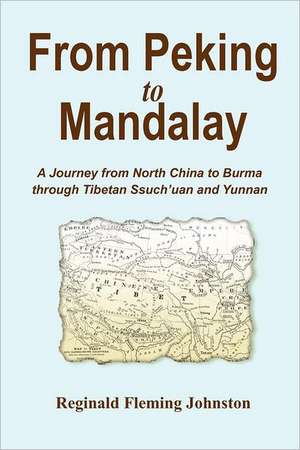From Peking to Mandalay
Autor Reginald Fleming Johnstonen Limba Engleză Paperback – 17 mar 2008
| Toate formatele și edițiile | Preț | Express |
|---|---|---|
| Paperback (2) | 153.63 lei 3-5 săpt. | |
| Soul Care Publishing – 17 mar 2008 | 153.63 lei 3-5 săpt. | |
| Cambridge University Press – 6 iun 2012 | 517.92 lei 6-8 săpt. |
Preț: 153.63 lei
Nou
Puncte Express: 230
Preț estimativ în valută:
29.40€ • 30.11$ • 24.46£
29.40€ • 30.11$ • 24.46£
Carte disponibilă
Livrare economică 26 februarie-12 martie
Preluare comenzi: 021 569.72.76
Specificații
ISBN-13: 9780968045978
ISBN-10: 0968045979
Pagini: 428
Dimensiuni: 152 x 229 x 22 mm
Greutate: 0.57 kg
Editura: Soul Care Publishing
Locul publicării:United States
ISBN-10: 0968045979
Pagini: 428
Dimensiuni: 152 x 229 x 22 mm
Greutate: 0.57 kg
Editura: Soul Care Publishing
Locul publicării:United States
Cuprins
Publisher's note; 1. Introduction; 2. Peking to Ichang; 3. Ichang to Wan-hsien through the Yangtse gorges; 4. Wan-hsien to Ch'eng-tu; 5. Ch'eng-tu to Omei-hsien; 6. Mount Omei and Chinese Buddhism; 7. Mount Omei; 8. Omei-hsien to Tachienlu; 9. Tachienlu; 10. Tachienlu to Pa-u-rong, Yalung River; 11. Pa-u-rong to Muli; 12. Muli to Yung-ning; 13. Yung-ning to Li-chiang; 14. Li-chiang to Tali-fu; 15. Ethnology of the Chinese far west; 16. Tali-fu to Bhamo; 17. Bhamo to Mandalay; 18. Conclusion; Appendices; Notes; General index; Index of names.
Descriere
Descriere de la o altă ediție sau format:
Published in 1908, this account of an epic journey across China offers a sympathetic and sensitive portrait of Chinese society.
Published in 1908, this account of an epic journey across China offers a sympathetic and sensitive portrait of Chinese society.

